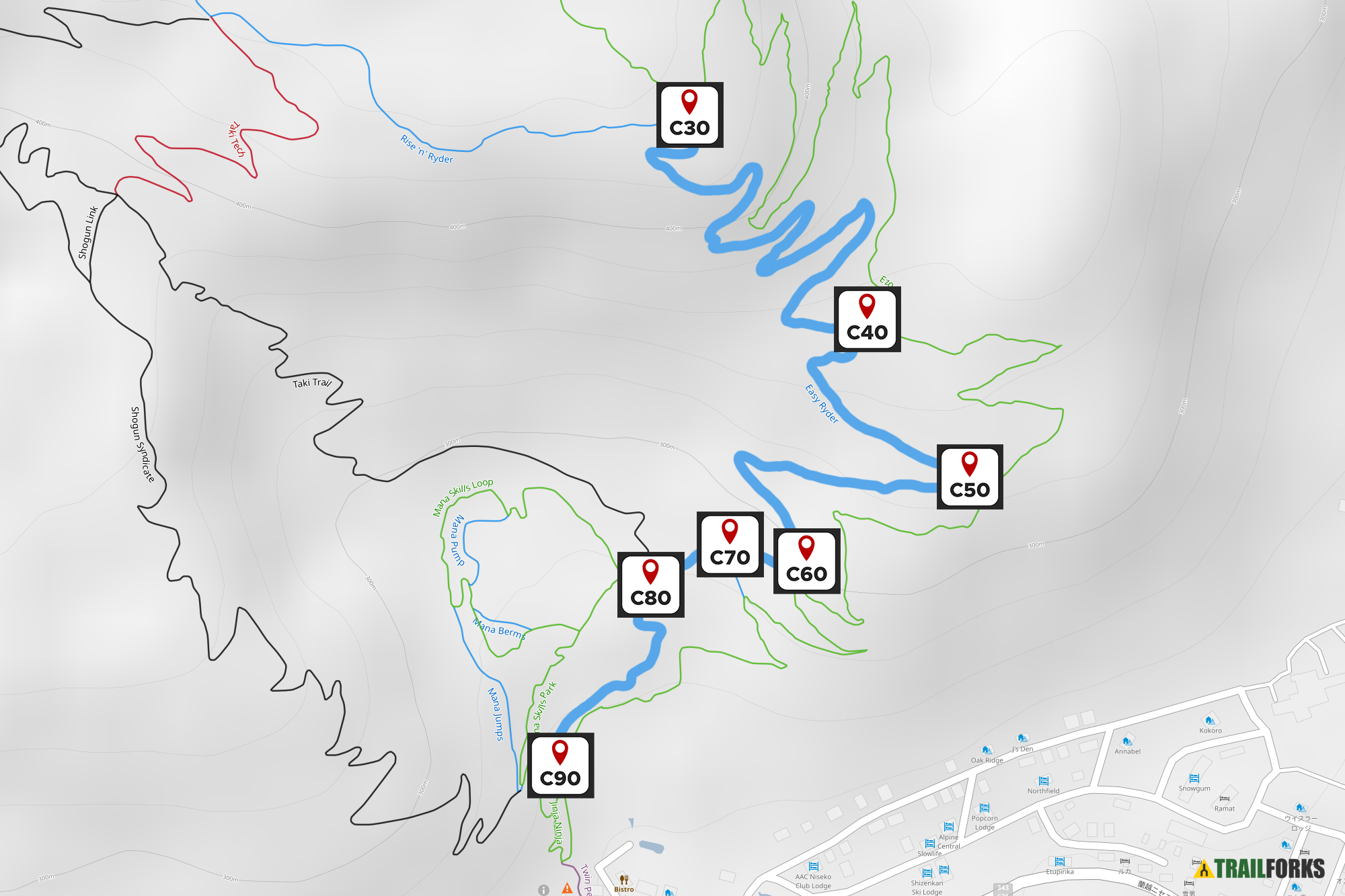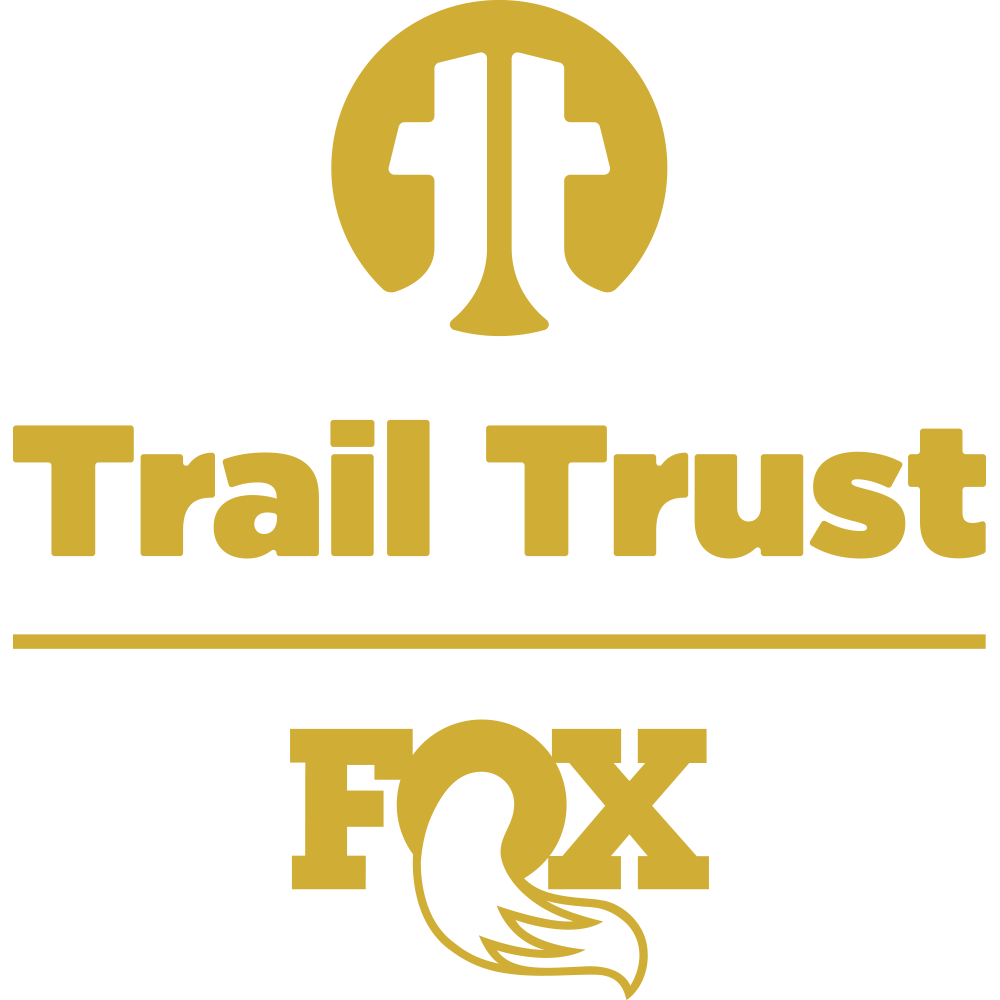Emergency Contacts:
Safe riding practices
NAMBA (the Niseko Area Mountain Bike Association) is committed to promoting safe and enjoyable experiences at the Twin Peaks Bike Park. Twin Peaks operates without a bike patrol and does not conduct an end-of-day sweep. Users of the trails, including mountain bikers, hikers, and trail runners, acknowledge and accept the inherent risks associated with these activities at their own discretion. Due to the natural environment, weather conditions, treefall, and other unforeseen events, trail conditions may change rapidly. Therefore, trail users are advised to operate at speeds that allow for sudden stops in the event of an unforeseen obstacle. Riders and users of the trails are responsible for their own safety and well-being.
Due to the varying trail conditions, NAMBA strongly encourages all users (in particular, mountain bikers) to follow these steps for safe riding:
- Pre-ride: warm up your body and mind, checking the trail at a slow pace and walking where necessary. Should you encounter technical trail features, dismount and study the feature to better understand their size, the speed required and the risks you accept when riding the feature.
- Re-ride: ride the trail repeatedly to check the trail and to better understand any features you intend to ride. When appropriate, dismount and study the feature to better understand its speed and technical elements.
- Freeride: once you have warmed up, and have grasped the technical nature of the trail and its features, enjoy! Start slow, and work your way up to higher speeds and bigger features.
Even when following safe riding practices, accidents can happen due to fatigue, changing trail conditions, maintenance and more. For all users, NAMBA strongly encourages all trail users to maintain personal liability insurance, mountain rescue coverage and injury insurance, and any other applicable insurance policies to protect themselves in case of accidents, injuries, medical emergencies, disasters, or death.
In the event of an accident, injury, medical emergency, disaster or death, please follow the emergency procedures prescribed below.
Emergency Procedures
To enhance trail user safety, NAMBA has developed the following emergency procedures to guide trail users in managing accidents, injuries, medical emergencies, disasters, or fatalities. The creation of these Emergency Procedures by NAMBA does not imply or constitute acceptance of liability for any injury, damage, loss, or harm that may occur while using the trails. Trail users are solely responsible for their own safety and well-being while using the Twin Peaks Bike Park trails.
-
Injuries and Medical Emergencies
Mountain biking, trail running and hiking all hold inherent risks. Accidents and medical emergencies may happen out on the trails.
In the event of an injury or other medical emergency:
-
Call 119 immediately
- If you or someone you encounter on trail is injured or experiencing a medical emergency requiring urgent medical attention, call emergency authorities immediately via 119. Be prepared to provide emergency authorities with location information (see 1.2).
- Do not move the injured person unless they are in immediate danger.
-
Provide Location Information
- Clearly and calmly inform emergency authorities that the accident has occurred within the Twin Peaks Bike Park.
- Inform the authorities of the precise location of the incident using a combination of GPS apps (available on your mobile phone on apps such as Trailforks), Twin Peaks trail names, and Twin Peaks location markers.
-
Administer First Aid
- If you have first aid training, and if it is safe to do so, administer first aid to the affected person including application of pressure to stop bleeding, immobilization of fractures.
- Check for responsiveness and breathing. If the affected person is unconscious, and if you are trained to do so, perform CPR.
-
Alert Others
- Use a whistle, your voice and/or your phone to call for help.
- If your party size is large enough to do so, position another member of your group up the trail to alert other trail users of the accident scene. If your group size is not conducive to this, consider placing a bicycle, backpack or other obstacle on trail to alert other riders of the accident. Do so in an area which has high visibility and provides other trail users with ample time to stop.
-
Stay with the Injured Person
- Remain with the injured person until professional help arrives. Keep them calm and reassured.
-
Additional tips
- Always carry a basic first aid kit, and know how to use it. Familiarize yourself with wilderness first aid procedures. Obtaining first aid training is strongly recommended.
- Communicate your trail plans to friends and family before you hit the trail. Provide them with an estimated return time, and instruct them to search for you should you not return on time.
- Staying calm in an emergency will help you think clearly, and will help you provide better assistance to the injured party.
By following these steps and by being prepared, you can help ensure a timely and effective response to any injuries or medical emergencies that may arise in the park. Please submit a voluntary incident report to NAMBA via incidents@namba.ngo.
-
Call 119 immediately
-
Fire Emergencies
Twin Peaks Bike Park is located within a preservation forest. Smoking, and use of open flames, is strictly prohibited but fires may still occur due to natural or other causes.
In the event of a fire:
-
Call 119 Immediately
- If you notice a fire, call 119 and report it to the authorities without delay. Be prepared to provide emergency authorities with location information (see 2.2).
- Follow any instructions from emergency services and park management.
-
Provide Location Information
- Clearly and calmly inform emergency authorities that the accident has occurred within the Twin Peaks Bike Park.
- Inform the authorities of the precise location of the fire using a combination of GPS apps (available on your mobile phone on apps such as Trailforks), Twin Peaks trail names, and Twin Peaks location markers.
-
Evacuate the Area
- Evacuate the area in a calm and orderly manner to the closest park exit at the bottom of the mountain. Move to a safe place as quickly as possible in a safe manner.
- Should you encounter others, inform them of the fire and instruct them to evacuate the park.
-
Use Fire Retardants
- If it is safe to do so, and you are trained in their use, use a fire extinguisher or other fire retardant to attempt to control the fire. Do NOT attempt to fight the fire if there is danger of injury, or if you have been instructed to evacuate by authorities.
-
Additional tips:
- Familiarize yourself with the park, its exits and any emergency facilities.
- Communicate with others to notify them of the fire. Ensure that they are aware of the need for evacuation.
- Stay calm. Help prevent panic, and ensure a safer evacuation for everyone.
- Monitor conditions, keeping an eye on wind direction, wind speed and other factors. These can affect the fire’s behavior, direction and strength – be prepared to change your evacuation route accordingly.
By following these steps and being prepared, you can help ensure a swift and effective response to fire emergencies in the park.
-
Call 119 Immediately
-
Missing Person
Twin Peaks Bike Park is located in a large area of forest between Niseko Tokyu Grand Hirafu and Niseko Hanazono ski Resorts. Maps and signage have been posted throughout the park – use these resources, and online mapping aps such as Trailforks, to familiarize yourself with the park and its layout. Despite these best efforts, persons may get lost and go missing within the wilderness of Twin Peaks.
In the event of a missing person:
-
Contact Authorities Immediately
- If someone is lost or missing, contact emergency services by telephoning 119 without delay. Follow their instructions.
- Provide a detailed description of the missing person, including any distinguishing features.
- Inform the authorities of the last known location of the missing person using a combination of GPS apps (available on your mobile phone on apps such as Trailforks), Twin Peaks trail names, and Twin Peaks location markers.
-
Initiate Search and Rescue
- If you are confident in your ability, initiate a speedy search along existing trails within the area where you think the person went missing. Rescue authorities will initiate search and rescue procedures based on the information provided on their arrival. Provide assistance to authorities as requested.
-
Additional Tips
- Stay calm. Keeping calm can help you provide clear and accurate information to authorities.
- Use any recent photos you may have taken of the missing person, and try to provide additional information such as clothing they’re wearing, age, height, weight and any identifying information such as tattoos, piercings, scars, hairstyle, etc.
- Inform others, including park visitors, park staff and others to increase awareness and help expand the search.
By following these steps, you can help ensure a prompt and effective response to locating a missing person in the park.
-
Contact Authorities Immediately
-
Natural Disasters
Japan is a seismically and volcanically active nation. Natural disasters and severe weather may strike at a moment's notice.
Follow these steps to ensure safety in the event of natural disaster or severe weather:
-
Evacuate the Park Immediately
- In the event of severe weather, such as lightning, heavy rain or strong winds, evacuate the park without delay.
- If evacuation is unsafe, shelter in place. Move to a safe area and consider the risks unique to the current weather phenomena. In high winds or lightning, avoid sheltering under trees. In heavy rain, avoid areas which may flood or landslide.
- Be mindful of dead trees, dead limbs and any other objects which pose injury risk from falling.
-
Follow Instructions From Authorities
- Check the news, and check for alerts on your phone, and follow any instructions provided by relevant authorities and/or by park management.
-
Additional Tips
- Before heading into the park, check the weather forecast. If the forecast calls for high winds, lightning or severe rains, consider making alternative plans.
- In the event of disaster, monitor conditions – be prepared to change your evacuation route accordingly.
By following these steps and being prepared, you can help ensure your safety and the safety of others during severe weather and natural disasters in the park.
-
Evacuate the Park Immediately
-
Wildlife Encounter
Twin Peaks is located in a forest surrounded by natural parks and national forests. This stunning natural environment is an ideal natural habitat for bears, deer, foxes and other wildlife. Trail users may unexpectedly encounter wildlife whilst out on the trail.
To avoid unexpected wildlife encounters it is recommended to always use a hiking bell, or bike bell, or similar device, to indicate your presence on the trail. Most animals will vacate the area if they hear you approaching.
Follow these steps to ensure safety in the event of a wildlife encounter:
-
Do Not Approach Wildlife
- If you encounter wildlife, maintain a safe distance. Do not approach, feed, or disturb them.
- Observe animals quietly and avoid making sudden movements or loud noises which may startle them.
-
Bear Encounters
- If you encounter a bear, back away slowly while facing the bear. Do not turn your back to the bear, or run from the bear.
- Make yourself appear larger by standing tall, raising your arms and holding your jacket open and/or holding your bike above your head. If available, equip your bear spray and be prepared to use it.
- Check your surroundings for bear cubs – you must NEVER get between a sow and her cubs, or approach bear cubs.
- Continue to back away from the bear until you are at a safe distance.
-
Protecting Yourself During a Bear Attack
- Protect vital areas, covering your head, neck and vital organs with your arms and hands to protect against bites and scratches.
- Use available objects to defend and/or shield yourself, such as your bicycle, branches, rocks or a backpack.
- If fighting back, aim for the eyes and nose.
- If playing dead, remain still until the bear no longer perceives you as a threat and leaves the area.
-
Additional tips
- Carry a bear bell, and consider making intermittent noise (such as clapping) to alert any wildlife to your presence.
- Equip yourself with bear spray and know how to use it.
- Never litter – including apple cores and other biodegradable food waste. Littering will attract bears and other wildlife.
- Familiarize yourself with the types of wildlife in the park, and learn about their behavior and any safety protocols to take in the event of an encounter.
- Be aware of your surroundings. Keep an eye out for tracks, scat or fresh marks on trees – all signs of wildlife activity in the area.
- Travel in groups when possible, as wildlife encounters are less likely to occur when traveling in large numbers.
By following these guidelines and being prepared, you can help ensure your safety and minimize the risk of dangerous wildlife encounters in the park.
-
Do Not Approach Wildlife
Emergency Equipment
Emergencies and disasters can happen even when we least expect them – even on a short ride or hike. All trail users are strongly encouraged to:
- Bring a packable first aid kit, including an emergency whistle and other supplies, and be trained on its use.
- Bring a bear bell/hiking bell, etc.
- Bring a multi tool / bike repair kit to address any punctures or mechanical issues which may occur on trail.
- Take plenty of food and water. Consider the length of your ride, and your physical condition, and prepare food and water accordingly.
- Keep their phone charged, and share a riding plan with friends and family.
- Bring personal identification, and any medical information (such as medical needs or medical allergies).
Signage and Emergency Assembly Points
Effective signage is crucial for ensuring the safety and navigation of all trail users. At Twin Peaks Bike Park, we have implemented a comprehensive system of signposts with location markers to aid in emergency situations and general navigation.
Location sign A10, located at Yamada Shrine, Izumikyo, is the current (as of July 2024) evacuation point of Twin Peaks Bike Park.
Below you can see an example of a trail sign, highlighting your current location; in this case it is C20.

The locations codes are on every trail sign, and so you can use these locations when contacting the emergency services.
Below shows the location codes for the full length of the Easy Ryder trail, starting from C30, progressing to C90.

General Information and Safety Best Practices
Reporting to NAMBA After an Emergency.
After ensuring safety and resolving an emergency, it is crucial to report the incident to the Niseko Area Mountain Bike Association (NAMBA) as soon as possible. Provide detailed information, including the time and date of the incident, the exact location using location markers, the nature of the emergency, actions taken, and any injuries sustained. Following the initial report, participate in any requested post-incident debriefing sessions with NAMBA. This helps improve future emergency responses and overall park safety. Additionally, offer any feedback or suggestions on enhancing safety measures and emergency procedures within the park.

































